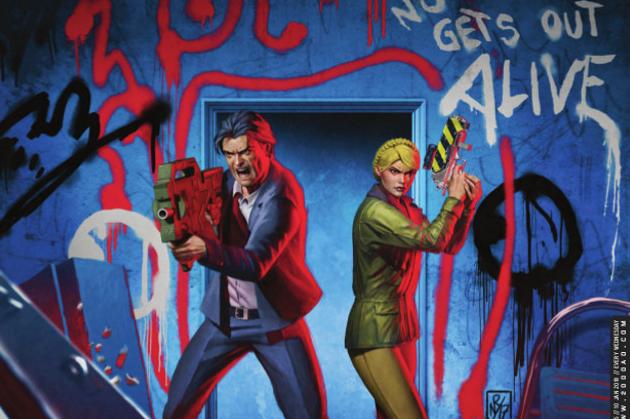2000AD, PROG 2063
Writers: Michael Carroll; Pat Mills; Ian Edginton; Peter Milligan
Artists: Colin MacNeil; Clint Langley; INJ Culbard; Patrick Goddard; Rufus Dayglo; Neil Roberts
Colourist: Chris Blythe; Dominic Regan
Letterers: Annie Parkhouse; Ellie De Ville; Simon Bowland
Publisher: Rebellion
The stomm hits the fan in this week’s Dredd: Echoes as the spirits of the dead finally come out of the shadows and attempt to kick Dredd’s butt in revenge for his nuking of East Meg One way back in 1982’s Apocalypse War. Whilst this episode is essentially just an extended fight scene, as before there are small suggestions as to Dredd’s true feelings as small amounts of empathy for his victims leak out. We also get our first insight into the future science behind the supernatural – and every opportunity to see the strange yet familiar sights of the retro-future soviet city should be snapped up.
There’s also a big fight in ABC Warriors: Fallout, as Hammerstein and Mongrol battle over how crazy Mongrol might be. Again, artist Clint Langley plays to his strengths as robots and scenery take the centre stage, allowing the photoshopped humans to lurk in the background. There’s slowly a plot forming here, between lecturing dialogue and bizarrely chosen satire.
With understated and simplistic art, INJ Culbard provides us with a slowly dying clockwork universe, where unimaginably vast structures are rules by godlike despots. Rooms as large as cities house armies of slaves, and whole races are designed and build to fulfil a single purpose. Amid this epic tale, a small band of outcasts struggle to compete a quest which will save the universe. Brass Sun: Engine Summer maintains a delicate balance of the personal and the epic. The scale accompanied by a leisurely paced plotting and dialogue heavy scenes might not be immediately compelling, and Brass Son might be better suited to reading in a single sitting.
Beelitz hospital is where Hitler spent two months as a young man after being injured during the Battle of the Somme in 1916. Originally built as a sanatorium, it was later used as a military hospital, first by the Nazis and then by the Soviets. After German reunification in the ‘90s, the building was abandoned. It remains today an empty shell, frequented by urban explorers and tourists curious about its morbid associations with oppressive regimes. It’s less than an hour’s journey from Berlin central train station, which is probably why Bill Savage was so eager to quickly defeat the robot army which interrupted his commute in Savage: The Thousand Year Stare. After being not at all surprised by the sudden appearance of a flying dreadnought, Bill decided the best way to escape it was by jumping on board, then managed to completely incapacitate the Transformers from the future with a single shot from a stun gun and run away. Imagine if Sarah Connor had just tazered the T1000 and gone home. Deranged serial killer Bill can then happily complete his journey to the building he frequently refers to as “Hitler’s Hospital”, with enough pages left to provide an explanation of how the abandoned building is actually a top secret government laboratory which, like the best top secret laboratories, only pretends to be derelict to lure people in, since this is the only way a fascist dictatorship could possibly obtain test subjects. Bill knows this because he previously had a conversation with a secret police man who forgot how interrogation works, and by randomly stopping a teenager in the street and showing him a picture of some grafitti.
Using the horrors of Nazism as a backdrop to fiction is fine. It's possibly the best way to examine the human willingness to accept the monsterous. Using Nazism as a haunted house to add weight to an empty story is not, nor is referencing the real life victims of sexual assault and murder of only a couple of decades ago to add flavour to your horror.
Many people love Bill Savage. Perhaps the strip appeals to nostalgia, with its brash lead character and old-school storytelling. I have difficulty getting past the need to blend an unreconstructed '70s British action man with a tangle of sci-fi ideas, and its overly simplistic storytelling mixed with an attempt to address important issues by shouting.
Bad Company: Terrorists continues on its path, with more fighting and squabbling between its broken gang of veterans. The psychedelic artwork and deformed characters engaged in graphic violence is fun, but this doesn’t seem to be going anywhere, or have much compelling to say. In this episode, the gang fight with each other, then stop and have a meal, then go to a pit fight. War is hell.





